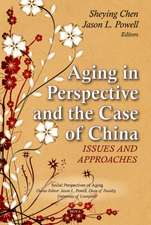The Transitions of Aging: International Perspectives on Aging, cartea 12
Autor Suchit Aroraen Limba Engleză Hardback – 28 apr 2015
The book first outlines the three eras of the Epidemiologic Transition, taking readers from its first stage where the threat of infectious diseases loom large, through the transitional stage, and on to the modern era, where non-communicable diseases are the primary cause of death. Next, the book examines the age-profiles of people whose childhoods coincide with the different stages of the Epidemiologic Transition. Using data from England and Wales, one of the few places that have recorded the data necessary for such an exploration, the book resolves the aging paradox by studying hidden generational change. It traverses historical time and identifies the distinct socio-economic and epidemiologic childhood conditions that may appear in it. It then compares, for instance, aging of children brought up in an earlier epidemiologic stage with aging of ones raised in a modern one. In the process, it explores the influence of childhood development on aging.
Overall, the book has a quantitative bent, engaging the reader with analytical issues that will help develop a deeper understanding of modern aging.
| Toate formatele și edițiile | Preț | Express |
|---|---|---|
| Paperback (1) | 385.08 lei 6-8 săpt. | |
| Springer International Publishing – 5 oct 2016 | 385.08 lei 6-8 săpt. | |
| Hardback (1) | 392.37 lei 6-8 săpt. | |
| Springer International Publishing – 28 apr 2015 | 392.37 lei 6-8 săpt. |
Din seria International Perspectives on Aging
-
 Preț: 297.75 lei
Preț: 297.75 lei - 20%
 Preț: 567.78 lei
Preț: 567.78 lei - 18%
 Preț: 901.64 lei
Preț: 901.64 lei - 15%
 Preț: 631.07 lei
Preț: 631.07 lei - 20%
 Preț: 576.05 lei
Preț: 576.05 lei - 15%
 Preț: 646.11 lei
Preț: 646.11 lei - 15%
 Preț: 648.42 lei
Preț: 648.42 lei - 18%
 Preț: 953.35 lei
Preț: 953.35 lei -
 Preț: 394.87 lei
Preț: 394.87 lei - 24%
 Preț: 694.68 lei
Preț: 694.68 lei - 15%
 Preț: 583.78 lei
Preț: 583.78 lei - 15%
 Preț: 698.94 lei
Preț: 698.94 lei -
 Preț: 446.37 lei
Preț: 446.37 lei - 18%
 Preț: 946.55 lei
Preț: 946.55 lei - 18%
 Preț: 785.42 lei
Preț: 785.42 lei - 15%
 Preț: 642.36 lei
Preț: 642.36 lei - 15%
 Preț: 582.80 lei
Preț: 582.80 lei - 18%
 Preț: 781.31 lei
Preț: 781.31 lei - 18%
 Preț: 889.29 lei
Preț: 889.29 lei - 18%
 Preț: 781.15 lei
Preț: 781.15 lei - 18%
 Preț: 1104.25 lei
Preț: 1104.25 lei - 15%
 Preț: 636.80 lei
Preț: 636.80 lei -
 Preț: 439.64 lei
Preț: 439.64 lei - 15%
 Preț: 473.49 lei
Preț: 473.49 lei - 24%
 Preț: 785.88 lei
Preț: 785.88 lei - 5%
 Preț: 1649.70 lei
Preț: 1649.70 lei - 18%
 Preț: 786.36 lei
Preț: 786.36 lei - 15%
 Preț: 651.99 lei
Preț: 651.99 lei
Preț: 392.37 lei
Nou
Puncte Express: 589
Preț estimativ în valută:
75.08€ • 78.75$ • 62.50£
75.08€ • 78.75$ • 62.50£
Carte tipărită la comandă
Livrare economică 01-15 aprilie
Preluare comenzi: 021 569.72.76
Specificații
ISBN-13: 9783319144023
ISBN-10: 3319144022
Pagini: 218
Ilustrații: XVI, 226 p. 50 illus.
Dimensiuni: 155 x 235 x 20 mm
Greutate: 0.52 kg
Ediția:2015
Editura: Springer International Publishing
Colecția Springer
Seria International Perspectives on Aging
Locul publicării:Cham, Switzerland
ISBN-10: 3319144022
Pagini: 218
Ilustrații: XVI, 226 p. 50 illus.
Dimensiuni: 155 x 235 x 20 mm
Greutate: 0.52 kg
Ediția:2015
Editura: Springer International Publishing
Colecția Springer
Seria International Perspectives on Aging
Locul publicării:Cham, Switzerland
Public țintă
ResearchCuprins
1: Aging and Non-Communicable Disease.- 2: The Epidemiologic Transition.- 3: The Profiles of Aging.- 4: Resolving the Paradox of Aging.- 5: Most Infectious Diseases Shrank with Age.- 6: The Macro Backdrop for Children.- 7: In the Natural Experiment.- 8: The Signals from the Childhood Years.- 9: Aging in Healthcare Policy.- 10: The Transitions of Aging.- Appendix.- Index.
Textul de pe ultima copertă
This book explores the unresolved paradox at the heart of population aging, namely how to account for the fact that death rates from most non-communicable diseases rise as people age, yet aggregate death rates from such diseases have decreased overall despite an increasingly aging population. It provides a long-term historical perspective on this issue, presenting evidence that the underpinnings of modern aging extend as far back as the nineteenth century, and that aging has boosted per capita healthcare spending.
The book first outlines the three eras of the Epidemiologic Transition, taking readers from its first stage where the threat of infectious diseases loom large, through the transitional stage, and on to the modern era, where non-communicable diseases are the primary cause of death. Next, the book examines the age-profiles of people whose childhoods coincide with the different stages of the Epidemiologic Transition. Using data from England and Wales, one of the few places that have recorded the data necessary for such an exploration, the book resolves the aging paradox by studying hidden generational change. It traverses historical time and identifies the distinct socio-economic and epidemiologic childhood conditions that may appear in it. It then compares, for instance, aging of children brought up in an earlier epidemiologic stage with aging of ones raised in a modern one. In the process, it explores the influence of childhood development on aging.
Overall, the book has a quantitative bent, engaging the reader with analytical issues that will help develop a deeper understanding of modern aging.
The book first outlines the three eras of the Epidemiologic Transition, taking readers from its first stage where the threat of infectious diseases loom large, through the transitional stage, and on to the modern era, where non-communicable diseases are the primary cause of death. Next, the book examines the age-profiles of people whose childhoods coincide with the different stages of the Epidemiologic Transition. Using data from England and Wales, one of the few places that have recorded the data necessary for such an exploration, the book resolves the aging paradox by studying hidden generational change. It traverses historical time and identifies the distinct socio-economic and epidemiologic childhood conditions that may appear in it. It then compares, for instance, aging of children brought up in an earlier epidemiologic stage with aging of ones raised in a modern one. In the process, it explores the influence of childhood development on aging.
Overall, the book has a quantitative bent, engaging the reader with analytical issues that will help develop a deeper understanding of modern aging.
Caracteristici
Exposes the hidden generational changes in aging Explores the influence of childhood development on aging Studies the role of aging in healthcare spending Provides a very long-term view covering two centuries Makes critical interdisciplinary links












